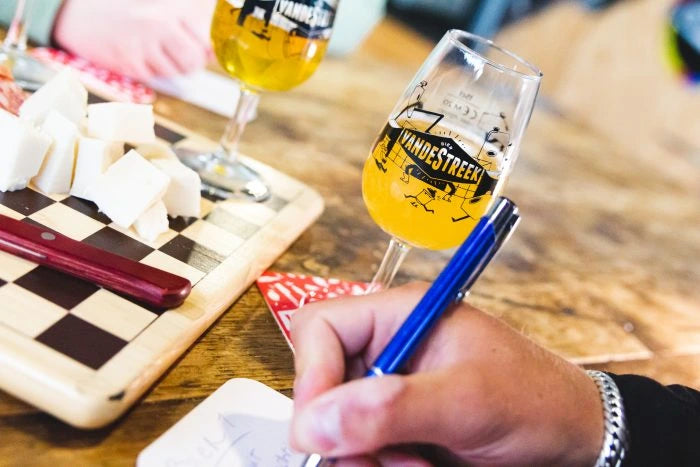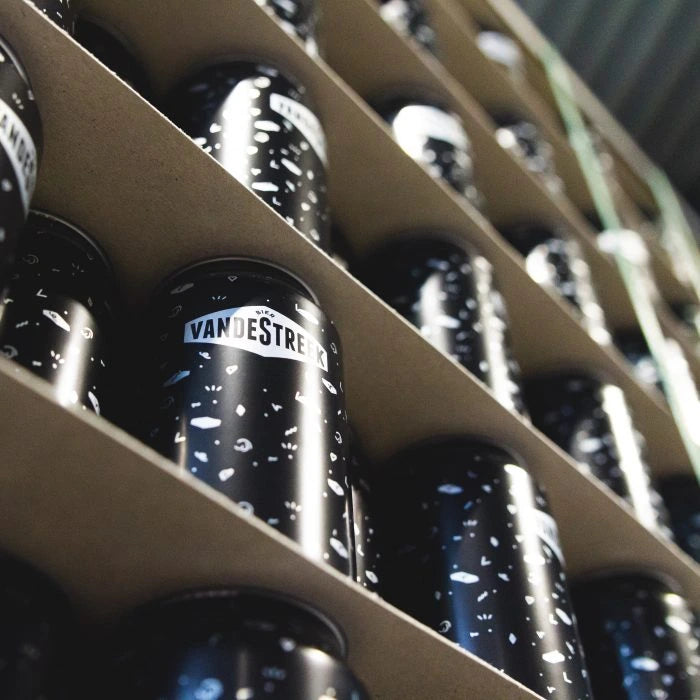- News
- /
How do you organize a home tasting?

Drinking beer with your friends on the terrace is fun. What's even more fun is having a beer tasting at home. You can let them discover new flavors. Testing whether they can indeed get the beer they like so much from the line-up. How good do alcohol-free IPAs really taste? You can compare beers with the same beer style. Or taste different beer styles side by side to see what's different about it. Possibilities galore!
Step 1: the preparation
Organizing a home tasting is simple. You choose a theme (see the introduction) and buy the required beers. One bottle or can of beer of 33 cl. is enough for three people. We are going to taste and you use small amounts for that. Of course you still have beer in the house for after the tasting, to enjoy afterwards. So getting a fourth or fifth beer from the tasting at home is smart; then you and your friends can actually drink the beer you liked best afterwards.
Six different beers is the max for a tasting. You want to take the time to taste each beer calmly. And, after six beers you already have quite a few impressions and you smell and taste less good. Especially if you are going to taste the same beer styles, everything can start to look alike.
Step 2: Determine the order
Determine the order in which you want to serve the beers. You can do that with increasing alcohol percentage, but usually you choose an increasing flavor intensity. Some heavy beers have a lower flavor intensity than lighter beers viz. You can taste the beers you are going to serve yourself in advance.
Step 3: arrange good glasses
Make sure you have the same beer glass for each participant. That pours easily; everything at the same level. That glass should not be too big. vandeStreek also has 15 cl tasting glasses for the tastings. Otherwise, white wine glasses work just fine too.

Ideal for your home tasting: the vandeStreek tasting glass!
Step 4: test form or chat freely?
You can use the tasting in an accessible way and let everyone smell and taste it quietly, or you can give the tasters a little more guidance. There are several test forms available online that you can use to indicate the structure of your tasting. With such a form you take the tasters with you: first look, then smell, only then taste and finally write down your findings.
Step 5: tasting
If you want people to taste blind, that is to say that they do not know what they are going to drink, then it is useful to pour the beers in a place where they cannot see the beers. If not, you can fill the glasses at the table. You serve the beers and let them look, smell and taste.
The color of a beer can say something about its taste. People often think that a dark beer is heavier than a paler beer. You don't have to: a tripel has a higher alcohol percentage than a Schwarzbier, for example. So, let your tasters look at the beer first. What color is it? Is it clear or cloudy? Does it have a lot or little foam?
The second step is smelling. This is already a difficult step for the inexperienced taster. You can help them by asking questions. If someone smells something fruity, is that tropical fruit? Or citrus? Or forest fruit? If someone smells something spicy, is it a dried herb, or fresh? Do they smell coffee? Chocolate? Etcetera. Prepare yourself by tasting and smelling the beers so you can help your friends.
The last step is tasting. The odors that emerge when smelling will often return as taste. Ask your tasters to focus on the basic flavors first: sweet, sour, bitter, and salty. Ask them about the intensity of those flavors. On a scale of one to five, how sweet, sour, bitter or salty is it? Here, too, you ask about the taste: which fruit, which type of coffee, chocolate, etc.
You can have six beers tasted in a row. Or you serve your beers in pairs, so people can compare the beers. That's nice if you always let the same beer styles be tasted. Or if you want to discover the differences between beer styles, such as a stout and porter, or a wheat beer and a Weizen. The taste of different hop varieties with IPAs.
Have a snack?
Serious beer tasters are only served dry crackers and water with their beers. This way they can neutralize their taste between each beer and therefore taste each subsequent beer well. It is of course also nice to have something to nibble when tasting. So put some nuts, or some sausage and cheese on the table. It will affect the taste of the beers, but that is also a nice test.
Let your tasters take a sip and taste the beer, then a bite of the sausage or cheese, and then another sip of beer. This way they can compare whether and how the food influences the taste of the beer, or maybe the beer influences the taste of the food. For the next tasting evenings, you can raise the bar and start experimenting: which cheese or sausage tastes best with which beer?
Don't forget the following: the important thing is that you have fun and enjoy the beers. Think about how your tasters are in it. Do not suddenly serve lager drinkers sour beers or thick chocolate stouts. Start with a white or a session IPA. Let your friends discover new flavors in peace. Or show them that they can't just recognize their favorite beer. Taste, discover, enjoy!

